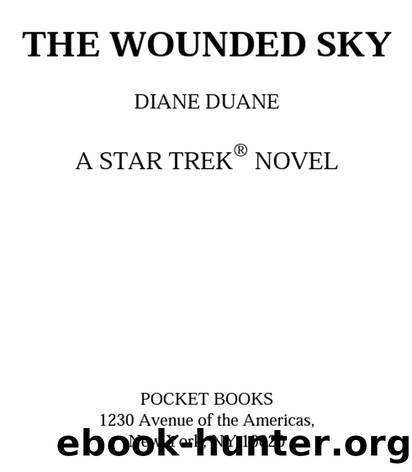The Wounded Sky (Star Trek: The Original Series Book 13) by Diane Duane

Author:Diane Duane [Duane, Diane]
Language: eng
Format: azw3
Publisher: Pocket Books/Star Trek
Published: 2000-09-21T16:00:00+00:00
Eight
Jim got to the turbolift and found that Spock had already caught one, losing him. I’ll never understand how he always manages to get a lift so fast. Maybe he has an understanding with the computer… .
The next lift arrived after what seemed several hours. When Jim stepped out of it onto Deck Four, down the hall from Astrocartography, he could hear excited voices already. He followed them into the big Astrocartography lab, and found Spock and Mayri Sagady and d’Hennish all bent over a huge worktable covered with live readouts and hard copy.
“Look at that light curve, Mr. Spock. It’s flat!”
“Instrument failure.”
“Sir, give me a break! You know very well I would triple-check the instrumentation before calling you in. It’s clean. Besides, look at the other stars in the cluster. There are all shades of curve, from bare fluctuation to near-normal—”
“What asymptotic relative efficiency?”
“Point, uh, three three five so far—”
“Have you determined an average of curve orders—”
“Will someone please—” Jim began. The jangling down the hall alerted him; he had just enough time to move out of the doorway before K’t’lk came charging through it—an effect like being almost run over by a xylophone. “Someone tell me what’s going on!” Jim said.
The three at the table looked up at him with mild surprise. “I’m telling you, sir,” d’Hennish said, and left the group. K’t’lk replaced him, climbing up onto a chair to look down at the data, and the polite wrangling began again.
Jim let d’Hennish lead him over to another readout console. “This is something really extraordinary, Captain,” the Sadrao said, sitting down at the console and bringing up a graph on the wall screen. “What I’m showing you is the way we get a sense of how any given star behaves over a length of time. We plot the star’s absolute magnitude—that’s its brightness on a standard scale—on the vertical line of the graph. Then the period of time over which we’re observing it goes on the horizontal line. The method’s being used in the past mostly for variables, but now we use it for all kinds of stars to forecast stellar weather. There’s always a little fluctuation in the curve, even with the steadiest stars.” D’Hennish patted the console, brought up a sample curve. “Sadr, my homestar. See the curve? A very very slight fluctuation, but regular. But look at one of the stars from the Lesser Magellanic.” Another graph came up—and the star’s magnitude line ran as straight across it as a flat EKG.
Jim shuddered. Even knowing as little as he did about the subject, he was disturbed. “Implications?”
D’Hennish looked disturbed too. “Sir, I’m not sure. The most obvious one is impossible.”
“What is it?”
“That entropy’s not working there.”
“Uh …” Jim nodded. “Thank you, Ensign.” He turned away from the console and stepped back over to the table.
“—uncomfortably like ‘symbiotic’ stars—”
“—prolonged ‘reverse novae’—”
“—tachyar artifact—”
“—unsupported theories about temporospatial ‘soluency’—”
“Pardon me,” Jim said, a bit loudly.
They all looked up at him again. “I get the feeling that this is going to go on awhile,” Jim said.
Download
This site does not store any files on its server. We only index and link to content provided by other sites. Please contact the content providers to delete copyright contents if any and email us, we'll remove relevant links or contents immediately.
Sita - Warrior of Mithila (Book 2 of the Ram Chandra Series) by Amish(51886)
The Crystal Crypt by Dick Philip K(35730)
Cat's cradle by Kurt Vonnegut(13944)
Always and Forever, Lara Jean by Jenny Han(13703)
Ready Player One by Cline Ernest(12923)
The Last by Hanna Jameson(9274)
Year One by Nora Roberts(8526)
Persepolis Rising by James S. A. Corey(8315)
The remains of the day by Kazuo Ishiguro(7614)
Dark Space: The Second Trilogy (Books 4-6) (Dark Space Trilogies Book 2) by Jasper T. Scott(7414)
Red Rising by Pierce Brown(7389)
Never let me go by Kazuo Ishiguro(7213)
The handmaid's tale by Margaret Atwood(6908)
The Circle by Dave Eggers(6300)
Legacy by Ellery Kane(5967)
Frank Herbert's Dune Saga Collection: Books 1 - 6 by Frank Herbert(5893)
The Testaments by Margaret Atwood(5828)
Pandemic (The Extinction Files Book 1) by A.G. Riddle(5630)
Six Wakes by Mur Lafferty(5243)
